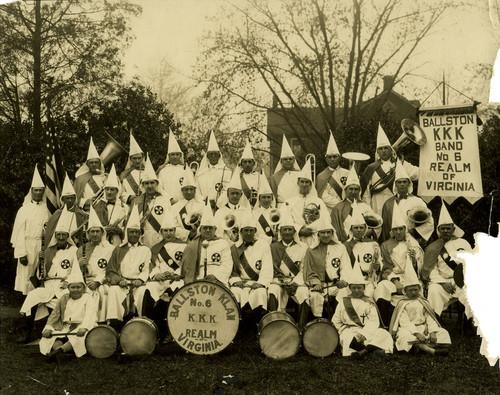Arlington and the KKK

In Arlington, Virginia, the KKK's chapter, based in Ballston, was most active during the 1920s
The Ku Klux Klan (KKK) espoused a deep racism, a fascination with mystical regalia, and a willingness to use violence to silence its opponents. It was also anti-immigrant, anti-Catholic, and anti-Semitic as strongly as it affirmed racism. The “secret” society had 3 million members during its heyday in the early 1920s. Roughly half its members lived in metropolitan areas or its suburbs, and although it enjoyed considerable support in the South, the Klan was strongest in the Midwest and Southwest and was strong in both major political parties.
In Arlington, Virginia, the KKK's chapter No. 6, based in Ballston, was most active during the 1920s, as reported by the local papers. The members resorted to sending threats to desegregation-minded people and intimidating them through public manifestations, such as marching in their pointed white hoods and uniforms, reminiscent of the Spanish Inquisition.
KKK's chapter No. 6 participated in the following events:
On August 8, 1925, members of the Ku Klux Klan gathered in Ballston at the intersection of Wilson and Glebe (Ballston Stadium) for a march on Washington.
On April 16, 1926, Ballston Klan No. 6 raised a flag at the Lyon Park Elementary School. More than 100 members, headed by a band, marched into a Parent Teachers Association reception.
On September 19, 1927, about 500 Klan members - men, women, and children - attended a Klan wedding at an Arlington home near Garrison Road, all clad in their white gowns and face masks, except the bride and the groom.
The public reaction to the KKK activities in Arlington, as well as the rest of the state, was mixed. Some supported them, but many others opposed them.
The white political and social elite consistently decried the KKK, not because they were opposed to white supremacy but because they viewed its methods as crass and unsophisticated.
In the late 1950s, the KKK was reborn, but mounting pressure from civil rights groups led the political establishment to commit to stamping out masked rallies and cross-burnings, making Virginia an inhospitable environment for its activity.
The KKK’s activities created a climate of fear and intimidation that could have influenced political activities in general. Although Klan klaverns still exist in the Commonwealth, there has been little public notice or concern of them since the late 1960s.
Images




